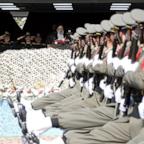Historic Election Newspapers, Scooped Up But Worthless?
Without proper care, historic Nov. 5 newspapers could fade and crumble.
Nov 14, 2008 — -- On Nov. 5, the morning after Barack Obama's presidential victory, history unfolded across the nation's front pages -- and many Americans wanted to save a piece of it.
Across the country, newspaper circulation numbers saw a spike, a welcome surge for the struggling industry.
On an average day, The New York Times prints 220,000 copies for newsstand distribution alone, but it went well beyond that for the election. To meet demand, the Times scrambled to print an additional 70,000 copies and, later, an additional 150,000, said Catherine Mathis, senior vice-president of corporate communication.
"That day we ran over 400,000 copies," Mathis said. "We sold out."
In Washington, after 350,000 copies of the Washington Post sold out within just a few hours that morning, an additional 350,000 copies were printed and distributed to high-traffic stores, including 7-Eleven, CVS, Safeway and other retailers, where demand for single copies of the historic edition was high.
But how to put a price on the keepsakes?
Without proper care, those banner headlines could fade and crumble even before Barack Obama's presidency is over, preservation experts say.
According to Carrie Christoffersen, curator of collections at the Newseum, a museum dedicated to journalism in Washington, D.C, newspapers are best stored in a dark room at 68 degrees Fahrenheit with 50 percent humidity. She says people often make the mistake of storing their commemorative newspapers in an attic or basement.
"Attics are often too hot and dry, and basements tend to be entirely too moist," says Christoffersen. "A better place is the back of your closet because there isn't a big temperature flux."
The main problem with preserving newspapers today stems from the relatively fragile nature of the materials used to print them at as low a cost as possible.
Before the mid-1800s, newspapers were made of cotton rag fibers, and many of those newspapers can be seen in good condition in museums and private collections today.
As it became cheaper to produce paper from wood pulp and less expensive chemicals for print, newspapers also became more degradable. The wood pulp makes them more brittle in hot and dry conditions while the acidity of the chemicals can eat away at the paper in moist environments.
The Library of Congress Web site states the best place to store newspapers is really a matter of good housekeeping. It suggests minimizing exposure of newspapers to dampness, heat, air pollutants, dust, insects and vermin, and putting them in places where they are protected from unexpected water damage.




